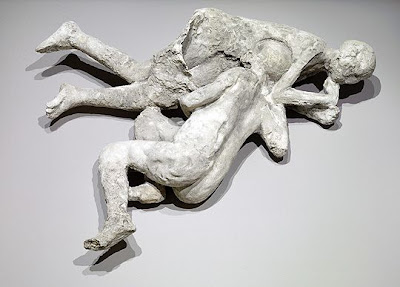 The world's oldest brothel is here. It's been here for over 2000 years. Which gives it a double distinction, if you think of the fact that prostitution is the world's oldest profession. How many lawyers' offices do you know that have been around for 2000 years?
The world's oldest brothel is here. It's been here for over 2000 years. Which gives it a double distinction, if you think of the fact that prostitution is the world's oldest profession. How many lawyers' offices do you know that have been around for 2000 years?
In the past 10 years alone, over a 100 million people have visited this brothel. If you calculate at the rate of 10 million visitors a year, by all accounts that's a conservative guess. The visitors are both men and women. And most of them leave open mouthed. That makes 10 million erotic thoughts. Whew!
It’s no ordinary brothel, this. It has ten rooms, five of which were on the first floor, reached by a small stairway, now barricaded. Each small room has a stone bed, stone bolster and wooden door. The walls are decorated with unashamedly erotic scenes, depicting the services offered by prostitutes and servants. Although the passage of time has dimmed the original colours, you can still decipher them visually. Astonishing.
As soon as my own erotic wanderings have subsided. Astonishing as everything in Pompeii is. It is believed that there were altogether 25 such brothels. This one, on the appropriately named Vicolo del Lupanare (Brothel Lane) is the only one that still exists. And the only business it conducts is the knowledge it offers. That sex was considered a necessity. Celebration. Enjoyment. The good life and more.
Everything I see in Pompeii points to this. What is even more surprising is how cleverly the archaeological uncovering of this buried city has been carried out. And the most astonishing thing for me is what a large and highly evolved town Pompeii was. After walking its paved streets for over five hours, my feet have covered only one fourth of the city.
Pompeii lay covered for nearly 2 millennia. Covered by the dust and debris of centuries, under a thick carpet of ash. On 24 August AD 79, the eruption of Mount Vesuvius destroyed both Pompeii and Herculaneum. The latter was submerged under layers of molten lava and mud, which explains why it was found better preserved than the former when both sites were rediscovered in the 18th century.
To discover Pompeii in this century we have driven from our home in Naples. The route is slightly inland, over roads that run parallel to the coastline. In 45 minutes we have arrived just outside the ruins of Pompeii. A short walk brings us to the ticket counters for this UNESCO World Heritage site. A nattily dressed man is going through the queues, exhorting visitors to use his immaculate services as an English-speaking guide. He finds only a few takers. 20,000 Lire per person for being guided, in addition to the 40,000 Lire entrance fee is not peanuts.
Although my hosts Cynthia and Clyde have visited Pompeii over ten years ago, it is as if we are all discovering it together .We are struck by the same irony when we look at the impressions of bodies made and kept here in certain homes. The ash which suffocated the inhabitants of Pompeii in their desperate att empts to escape, (or the equally vain attempt to take refuge in the innermost parts of the buildings) has paradoxically preserved at least part of the life of this great city for us voyeurs.
empts to escape, (or the equally vain attempt to take refuge in the innermost parts of the buildings) has paradoxically preserved at least part of the life of this great city for us voyeurs.
Protected by walls some 3 km long, this was a prosperous city, vital, bustling with pedestrians and traffic, and full of hotels, inns, shops, grandiose public buildings, temples and private homes. Painted walls were an essential element of decoration. Fantasy, illusion and mythological motifs prevailed, accompanied by rich decoration. Preserved walls in the Villa of Mysteries, the Vettius House and the Orchard House are stunning examples of this. Also of great importance was sculpture, apparent from works of great value and beauty that came to light during the excavations.
Private homes were of two types – pre-Samnite and Italic – built around a central atrium. On top, a four-pitched roof sloped towards the interior. A central opening in the roof provided light and a supply of rainwater, collected in a tank below which was connected to a cistern. So there was never a water shortage. Just looking at this makes me wonder. Why is it that our 21st century officials can't learn from ancient civilizations?
Pompeii, a city caught in a time warp is teaching us a lot of lessons. The most telling one is that it makes me realise how little mankind has really advanced. Maybe we do deserve to be ruled by the idiot box.
Monday, July 20, 2009
Pompeii: a trip to Pompeii history pictures visit volcano map destruction
Subscribe to:
Post Comments (Atom)
Explore more

Custom Search
1 comment:
golden goose sneakers
jordan shoes
air max
hermes belt
air max 270
goyard
adidas yeezy boost
moncler
kyrie 6 shoes
cheap jordans
Post a Comment